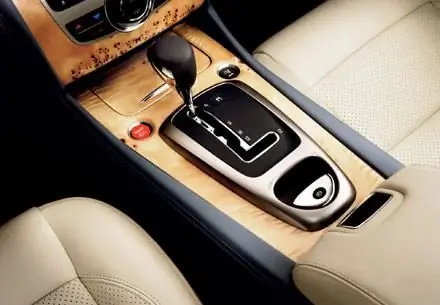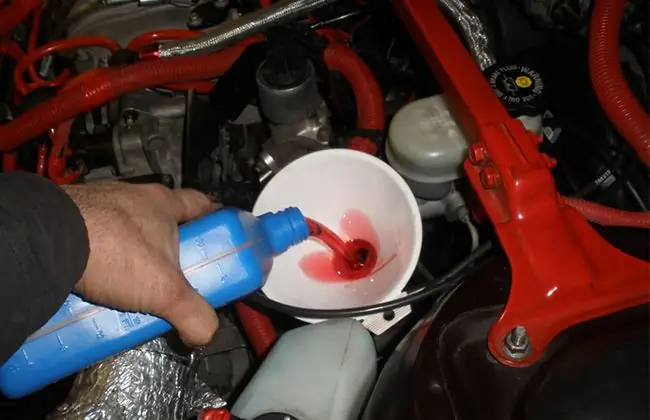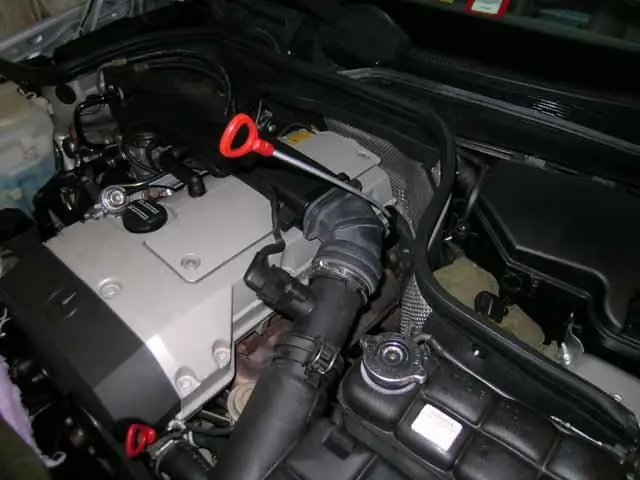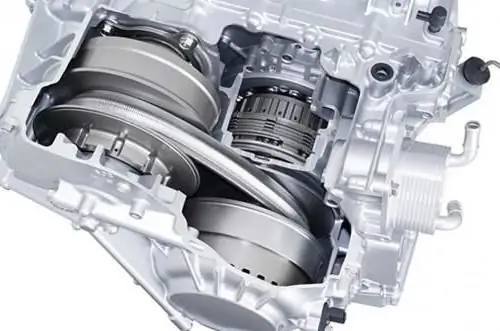2025 Author: Erin Ralphs | [email protected]. Last modified: 2025-01-22 21:14:09
Today, many novice drivers, and motorists with experience, choose a car with an automatic transmission. Beginners, as a rule, are often afraid of the very need to shift gears while driving, but experienced drivers simply appreciated the possibilities of calm and measured movement in a car equipped with automatic transmission. But when a beginner buys his personal car, he often does not know how to properly operate the “automatic”. Unfortunately, this is not taught in driving schools, and traffic safety and the life of the gearbox mechanisms depend on this. Let's see how you need to operate the automatic transmission so that you do not have problems with it in the future.

Types of automatic transmissions
Before talking about how to drive an automatic transmission, it is necessary to consider the types of units that manufacturers equip modern cars with. It depends on what type this or that box belongs to.and how to use it.
Torque converter gearbox
This is probably the most popular and classic solution. Torque converter models are equipped with most of all cars that are produced today. It was with this design that the promotion of automatic transmission to the masses began.
It must be said that the torque converter itself is not actually an integral part of the shift mechanism. Its function is the clutch on the "automatic" box, that is, the torque converter transmits torque from the engine to the wheels in the process of starting the car.
The engine and mechanism of the "machine" do not have rigid connections with each other. The rotational energy is transmitted using a special gear oil - it constantly circulates in a vicious circle under high pressure. This circuit allows the engine to run in gear when the machine is stationary.
The hydraulic system is responsible for switching, or rather, the valve body, but this is a general case. In modern models, operating modes are determined by electronics. So, the gearbox can operate in standard, sport or economy mode.
The mechanical part of such boxes is reliable and quite repairable. The hydroblock is a weak point. If its valves do not work properly, then the driver will face unpleasant effects. But in the event of a breakdown, there are automatic transmission spare parts in stores, although the repair itself will be quite expensive.
As for the driving characteristics of cars equipped with torque converter gearboxes, they depend on the electronics settings - this is an automatic transmission speed sensor andother sensors, and as a result of these readings, a command is sent to switch at the right time.

Previously, these boxes were offered with only four gears. Modern models have 5, 6, 7 and even 8 gears. Higher gear ratios improve driving dynamics, ride and shifting and fuel economy, according to manufacturers.
Stepless variator
In appearance, this technical solution does not differ from the traditional “machine”, but the principle of operation here is completely different. There are no gears here, and the system does not shift them. Gear ratios change constantly and without interruption - it does not depend on whether the speed decreases or the engine spins up. These boxes provide maximum smoothness of operation - this is comfort for the driver.
Another plus for which CVTs are so loved by drivers is the speed of work. This transmission does not waste time in the shifting process - if it is necessary to pick up speed, it will immediately be at maximum effective torque to give the car acceleration.

Automatic transmission: how to use
Let's consider the operating modes and operating rules for conventional traditional torque converter machines. They are installed on most vehicles.
Main automatic transmission modes
To determine the basic rules of operation, you must first understand the operating modes that thesemechanisms.
For all cars with automatic transmission, without exception, the following modes are required - these are “P”, “R”, “D”, “N”. And so that the driver can select the desired mode, the box is equipped with a range selection lever. In appearance, it is practically no different from a manual transmission selector switch. Its difference is that the gear change process is carried out in a straight line.
The modes are displayed on the control panel - it is very convenient, especially for novice drivers. While driving, there is no need to take your eyes off the road and lower your head to see what gear the car is in.
Automatic transmission mode "P" is parking. In this mode, all elements of the car will be turned off. It is worth moving into it only during long stops or parking. The motor is also started from this mode.
"R" - reverse gear. When this mode is selected, the machine will drive in reverse. It is recommended to turn on reverse gear only after the car has completely stopped; it is also important to remember: the rear is activated only when the brake is fully depressed. Any other algorithm of actions can cause significant harm to the transmission and motor. This is very important to know for all those who have an automatic transmission. How to use it correctly, experts and experienced drivers advise. Pay close attention to these tips, they will help a lot.
"N" - neutral, or neutral gear. In this position, the motor no longer transmits torque to the chassis and runs in idle mode. It is recommended to use this gear only for short stops. Also, do not include the box in the neutral position while driving. Some professionals advise towing a car in this mode. When the automatic transmission is in neutral, the engine cannot be started.

Automatic transmission modes
"D" - driving mode. When the box is in this position, the car moves forward. In this case, the gears are switched alternately in the process of pressing the gas pedal by the driver.
Automatic car can have 4, 5, 6, 7 and even 8 gears. The range selection lever on such cars can have several options for moving forward - these are “D3”, “D2”, “D1”. Designations can also be without a letter. These numbers indicate the top gear available.
In "D3" mode, the driver can use the first three gears. In these positions, braking is much more effective than in the usual "D". This mode is recommended to be used when it is simply impossible to drive without braking. Also, this transmission is effective during frequent descents or ascents.
"D2" is, respectively, only the first two transfers. In this position, the box is transferred at speeds up to 50 km / h. Often this mode is used in difficult conditions - it can be a forest road or a mountain serpentine. This position makes maximum use of the engine braking capability. You also need to transfer the box to "D2" in traffic jams.
"D1" is only the first gear. In this position, automatic transmission is used if the car is difficult to accelerate above 25 km / h. An important tip for those with an automatic transmission(how to use all its features): do not turn on this mode at high speeds, otherwise there will be a skid.
"0D" - increased row. This is an extreme position. It should be used if the car has already gained speed from 75 to 110 km / h. It is recommended to leave the transmission when the speed has dropped to 70 km / h. This mode allows you to significantly reduce fuel consumption on highways.
You can turn on all these modes in any order while the car is moving. Now you can only look at the speedometer, and the tachometer is no longer needed.

Additional modes
Most transmissions also have assist modes. These are Normal, Sport, Overdrive, Winter and Economy.
Normal mode is used under normal conditions. Economic allows you to achieve a smooth and quiet ride. In sports mode, the electronics use the engine to the maximum - the driver gets everything that the car is capable of, but you will have to forget about savings. Winter mode is designed for operation on slippery surfaces. The car starts off not from the first, but from the second or even from the third gear.
These settings are often turned on with separate buttons or switches. It must also be said that, despite all the benefits for drivers that an automatic transmission provides, drivers want to drive a car. There is nothing better than changing gears in your car. To solve this problem, Porsche engineers created an automatic transmission modeTiptronic. This is a handmade imitation with a box. It allows you to manually upshift or downshift as needed.

Automatic transmission: how to drive
In the process of starting the car from a place, as well as when changing the direction of movement, the operation mode of the box is switched with the brake pressed. When changing direction, also do not temporarily set the box to neutral.
It is recommended to take your foot off the brake only after the driver feels a characteristic push - this indicates that the gear is fully engaged.
If you need to stop at a traffic light, as well as in case of traffic jams, do not set the selector to the neutral position. It is also not advised to do it on the descents. If the car is slipping, then you do not need to press hard on the gas - this is harmful. It is better to shift into lower gears and use the brake pedal to let the wheels spin slowly.
The rest of the subtleties of working with automatic transmissions can only be comprehended with driving experience.

Operating Rules
The first step is to press the brake pedal. Then the selector is put into driving mode. Next, release the parking brake. The brake pedal should go down smoothly - the car will start to move. All shifts and manipulations with the automatic transmission are done through the brake with the right foot.
To slow down, it is best to release the gas pedal - all gears will shift automatically.
Basic rule - no sharp setsspeed, sudden braking, any sudden movements. This leads to wear of the friction discs and an increase in the distance between them. This can then lead to unpleasant jolts when shifting the automatic transmission.
Some professionals advise to give the box a rest. For example, when parking, you can let the car roll at idle, without gas. Only after that you can put pressure on the accelerator.

Automatic transmission: what not to do
It is strictly forbidden to load an unheated machine. Even if the positive air temperature is kept outside the car, the first kilometers are best overcome at low speeds - sharp accelerations and jerks are very harmful to the box. A novice driver should also remember that in order to fully warm up the automatic transmission, it takes more time than to warm up the power unit.
The automatic transmission is not designed for off-road and extreme use. Many modern gearboxes of a classic design do not like wheel slip. The best way to drive in this case is to avoid a sharp increase in speed on bad roads. If the car is stuck, a shovel will help - do not put too much load on the transmission.
Also, experts do not recommend overloading classic automatic transmissions with high loads - the mechanisms overheat and, as a result, wear out more and faster. Towing trailers and other cars is a quick death for the machine.
In addition, you should not start cars equipped with automatic transmissions with"pusher". Although many motorists break this rule, it should be remembered here that this will not pass without a trace for the mechanism.
Also be sure to remember some features in switching. In the neutral position, you can stay, but subject to holding the brake pedal. In the neutral position, it is forbidden to turn off the power unit - this can only be done in the "Parking" position. It is forbidden to move the selector to "Park" or to the "R" position while driving.

Typical malfunctions
Among the typical malfunctions, specialists point out a broken backstage, oil leaks, problems with electronics and valve body. Sometimes the tachometer does not work. Also, sometimes there are problems with the torque converter, the engine speed sensor does not work.
If, when using the box, there are any difficulties when moving the lever, then these are signs of problems with the selector. The solution requires replacing the part - automatic transmission parts are available in automotive stores.
Often, many breakdowns occur due to oil leaks from the system. Often, automatic boxes leak from under the seals. It is necessary to inspect the units more often on a flyover or a viewing hole. If there are leaks, then this is a signal that urgent repair of the unit is necessary. If everything is done on time, then the problem can be solved by changing the oil and seals.
On some cars it happens that the tachometer does not work. If the speedometer also stops, then the automatic transmission may go into emergency operation. Often these problemssolved very, very simply. The problem lies in a special sensor. If you replace it or clean its contacts, then everything returns to its place. It is necessary to check the automatic transmission speed sensor. It is located on the body of the box.
Also, motorists are faced with incorrect operation of the automatic transmission due to problems in the electronics. Often the control unit incorrectly reads the revolutions for switching. The reason for this may be the engine speed sensor. Repairing the unit itself is pointless, but replacing the sensor and cables will help.
Very often the valve body fails. For example, this can happen if the driver incorrectly operated the transmission. If the car did not warm up in winter, then the valve body is very vulnerable. Problems with the hydraulic unit are often accompanied by various vibrations, some users diagnose shocks when switching automatic transmissions. In modern cars, the on-board computer will help you find out about this breakdown.
Automatic transmission operation in wintertime
Most automatic transmission breakdowns happen in winter. This is due to the negative impact of low temperatures on the resources of the system and the fact that the wheels slip on ice when starting off - this also does not have the best effect on the condition.
Before the onset of cold weather, a motorist should check the condition of the transmission fluid. If inclusions of metal shavings are noticed in it, if the liquid has darkened and become cloudy, then it should be replaced. As for the general rules for changing oil and filters, this is recommended for operation in our country.do every 30,000 km of the car.
If the car is stuck, then you should not use the "D" mode. In this case, downshifting will help. If there are no lowered ones, then the car is pulled forward and backward. But don't overdo it.
To avoid skidding when downshifting on a slippery road, for front-wheel drive cars you need to hold the accelerator pedal, on rear-wheel drive cars, on the contrary, release the pedal. It is better to use lower gears before turning.

That's all there is to say about what an automatic transmission is, how to use it, and what rules to follow. At first glance, it may seem that this is an extremely fastidious mechanism with a small working resource. However, subject to all these rules, this unit will live the entire life of the car and will delight its owner. Automatic transmissions allow you to fully immerse yourself in the driving process, without thinking about choosing the right gear - the computer has already taken care of this. If you service the transmission in time and do not load it beyond its capabilities, it will bring only positive emotions while using the car in various conditions.
Recommended:
The automatic transmission device of a car and the principle of operation. Automatic transmission types

Recently, automatic transmissions are gaining more and more popularity. And there are reasons for that. Such a box is easier to operate and does not require constant “play” with the clutch in traffic jams. In large cities, such a checkpoint is far from uncommon. But the automatic transmission device is significantly different from classical mechanics. Many motorists are afraid to take cars with such a box. However, the fears are not justified. With proper operation, an automatic transmission will last no less than mechanics
Automatic transmission: oil filter. Do-it-yourself oil change in automatic transmission

Modern cars are equipped with different gearboxes. These are tiptronics, CVTs, DSG robots and other transmissions
Do I need to change the oil in the automatic transmission? Description of the automatic transmission, timing and method of oil change

Automatic transmission is the second most popular. But nevertheless, this gearbox is gradually replacing the mechanics, which so far occupies a leading position. Automatic transmission has a number of advantages, the main of which is ease of use
How to check the oil level in automatic transmission? Oil for automatic transmission. Oil dipstick

In this paper, the question is considered: "How to check the oil level in automatic transmission?" And also directly with the help of which the oil level in the automatic transmission is checked. Tips are given on the selection of oil, instructions are given for changing it yourself
Oil for "Hyundai Solaris". What oil to use for the engine and automatic transmission. List of verified manufacturers

Solaris ranks first in sales not only in Russia, but throughout the world. A car is bought for excellent driving performance, a reliable engine and a comfortable interior. During the warranty period, all car owners are serviced by an authorized dealer and do not wonder what kind of oil is in the Hyundai Solaris engine and what needs to be poured into the transmission

